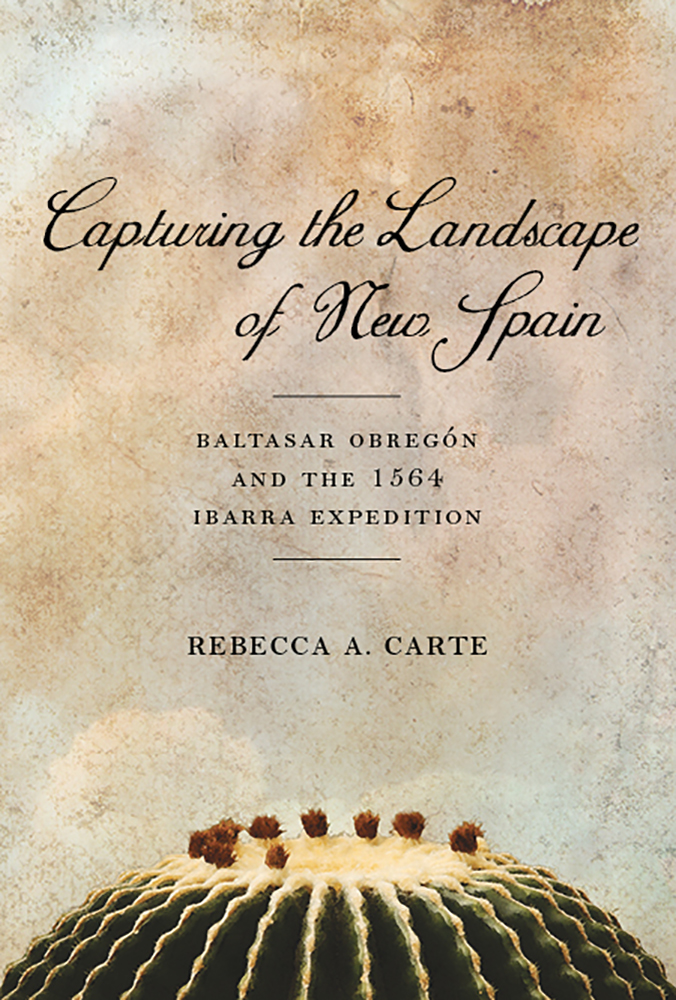Capturing the Landscape of New Spain
Baltasar Obregón and the 1564 Ibarra Expedition
Hardcover ($52.00), Ebook ($52.00)
Buy
The son of an encomendero, Baltasar Obregón was twenty years old when he joined the 1564 expedition led by the first governor of Nueva Vizcaya, Francisco de Ibarra. The purpose of the expedition was to establish mining settlements in the borderlands of New Spain and to suppress indigenous rebellions in the region.
Although Obregón’s role in the Ibarra expedition was that of soldier-explorer, and despite his lacking an advanced education, he would go on to compose Historia de los descubrimientos de Nueva España twenty years later, expanding his narrative to include the years before and after his own firsthand experiences with Ibarra. Obregón depicts the storied landscape of the northern borderlands with vivid imagery, fusing setting and situation, constructing a new reality of what was, is, and should be, and presenting it as truth.
In Capturing the Landscape of New Spain, Rebecca A. Carte explains how landscape performs a primary role in Obregón’s retelling, emerging at times as protagonist and others as antagonist. Carte argues that Obregón’s textualization offers one of the first renderings of the region through the Occidental cultural lens, offering insight into Spanish cultural perceptions of landscape during a period of important social and political shifts.
By examining mapping and landscape discourse, Carte shows how history and geography, past and present, people and land, come together to fashion the landscape of northern New Spain.
Although Obregón’s role in the Ibarra expedition was that of soldier-explorer, and despite his lacking an advanced education, he would go on to compose Historia de los descubrimientos de Nueva España twenty years later, expanding his narrative to include the years before and after his own firsthand experiences with Ibarra. Obregón depicts the storied landscape of the northern borderlands with vivid imagery, fusing setting and situation, constructing a new reality of what was, is, and should be, and presenting it as truth.
In Capturing the Landscape of New Spain, Rebecca A. Carte explains how landscape performs a primary role in Obregón’s retelling, emerging at times as protagonist and others as antagonist. Carte argues that Obregón’s textualization offers one of the first renderings of the region through the Occidental cultural lens, offering insight into Spanish cultural perceptions of landscape during a period of important social and political shifts.
By examining mapping and landscape discourse, Carte shows how history and geography, past and present, people and land, come together to fashion the landscape of northern New Spain.
"Rebecca Carte shows us to see how narration and description, history and geography, past and present, people and land, together fashion the ‘landscape’ of northern New Spain, a collection of places and non-places bound into a meaningful and usable whole. She provides a model that we can use to approach other texts from this vast corpus, texts that cry out of the sort of spatial analysis exemplified here but only too rarely brought to bear upon them.”—Ricardo Padrón, author of The Spacious Word: Cartography, Literature, and Empire in Early Modern Spain
“…for explorers of discovery, Capturing the Landscape of New Spain offers a fine example of how multiple mental ‘textualscapes’ can be found not just in maps but in the reports of explorers and conquerors.”—Gene Rhea Tucker, Terrae Incognitae
“…for explorers of discovery, Capturing the Landscape of New Spain offers a fine example of how multiple mental ‘textualscapes’ can be found not just in maps but in the reports of explorers and conquerors.”—Gene Rhea Tucker, Terrae Incognitae
“Carte’s sensitive reading of the cultural landscape makes a fundamental contribution to our understanding of early Spanish exploration in Mexico.”—Western Historical Quarterly
 The University of Arizona Press
The University of Arizona Press

